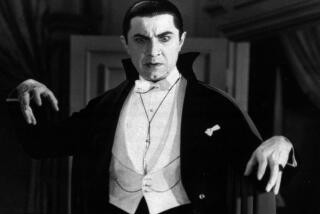Reviews: Frankenstein and Dracula cast their shadows in new books
When Mary Shelley wrote “Frankenstein” in 1816, she could not have conceived of the cultural landmark it would become. The novel still throws a long shadow across the popular imagination almost two centuries later. Boris Karloff’s performance as the monster in Universal’s 1931 film has become iconic, and his is merely one among dozens of adaptations and revisions to come: movies, plays, novels, comic books, even breakfast cereals (remember Franken Berry?).
Which brings us to Dave Zeltserman’s “Monster” (Overlook: 224 pp., $23.95). Shelley’s original is an ingeniously constructed set of nested narratives, with the monster’s story embedded at the heart. Zeltserman dispenses with this complex framing device and gives us the monster’s story straight. His first-person narrative is itself an impressive achievement: He manages the difficult trick of creating a voice that sounds authentically like Shelley’s while remaining entirely lucid to the contemporary reader.
More impressively, Zeltserman’s plot maps almost perfectly onto the plot of Shelley’s novel — the key word being “almost.” In its departures, the novel provides more than its cover price in entertainment. Vampyres (Zeltserman’s spelling) abound, as do Satanic cults and the Marquis de Sade, preparing to enact the 120 Days of Sodom in a remote mountain castle. You don’t get much more gothic bang for your buck.
Yet the age wants something more than an entertainment. Shelley’s masterpiece is a meditation on the dawning age of science. Frankenstein is ahead of his time, endowing dead flesh with life via galvanism, a technique as cutting edge and mysterious in Shelley’s era as nanotechnology is today. The subtitle of Shelley’s novel, “The Modern Prometheus,” attests to her fear that science might indeed someday steal the fire of creation from God himself. The book stands as a stark warning against unfettered scientific ambition.
Zeltserman’s Frankenstein dispenses with science, however. His Frankenstein creates his monster using satanic magic derived from forbidden tomes of alchemy. Thematically, this is a step back — and not a small one. For what real relevance can Zeltserman’s vampyres, spells and satanic cults have in a world that hovers on the edge of scientific catastrophe? Ironically, despite their publication dates, Shelley’s novel remains the more relevant, an enduring testament to the power of literature to speak not merely to its own age but to all ages.
*
In “Vlad” (Dalkey Archive Press: 124 pp., $17.95), Carlos Fuentes takes on Bram Stoker’s “Dracula.” Fuentes, who died this year at 83, is not the first to do so. Vampire-like, Stoker’s novel continues to exert mesmerizing power over readers — and writers — more than a century after its publication. It has come to be an ur-text, upon which new levels of significance can be layered like paint. Or so Fuentes would have us believe. And, in this strange and compelling novella, he nearly pulls it off.
In its opening — and most convincing — scenes, Mexico City’s Yves Navarro takes on the real-estate broker role of Stoker’s Jonathan Harker, the solicitor assigned to settle Dracula in London. Like Harker, Yves finds himself imprisoned in Vlad’s home. And like Harker, he explores the diseased house, discovering the eponymous vampire sleeping in a coffin in the passage that runs under the yard.
Not that there aren’t plenty of lacerating additions of Fuentes’ own, including, most horrifyingly, Vlad’s dismissal of humans as blood sausages, and the drains that line the corners of the rooms where he consumes them. Yet when the book diverges from Stoker’s text to layer fresh meanings onto the myth, “Vlad” goes astray. The story becomes increasingly improbable — how did Vlad come across the picture of Yves’ daughter in his perusal of “the enormous quantity of photographs” that set him on his journey to Mexico City? And is there anything in the nature of that search that we haven’t seen dozens of times before: Dracula’s quest to find his one true love?
More problematic, the novel fails to develop the strains of social satire that are hidden just beneath the surface. Offered immortality with his wife and daughter, Yves decides to remain human — so he can continue to enjoy the small comforts of “work, health, and pleasure that are permitted to us human beings.”
One senses a critique of the upper-middle-class life Yves sketches early in the novel, when Vlad exclaims that nothing we create, “careers, politics … even art … can save us from idiocy and from death.” But if the novel intends to satirize that middle-class life, it needs to offer Yves a genuine choice. And given the option of passing eternity with a blood-sucking, bat-eared immortal that drops such leaden lines as “I never drink … wine,” who wouldn’t choose the pleasures of the daily commute?
Bailey is the author of the novel “House of Bones” and a collection of short stories, “The Resurrection Man’s Legacy and Other Stories.”
More to Read
Sign up for our Book Club newsletter
Get the latest news, events and more from the Los Angeles Times Book Club, and help us get L.A. reading and talking.
You may occasionally receive promotional content from the Los Angeles Times.







